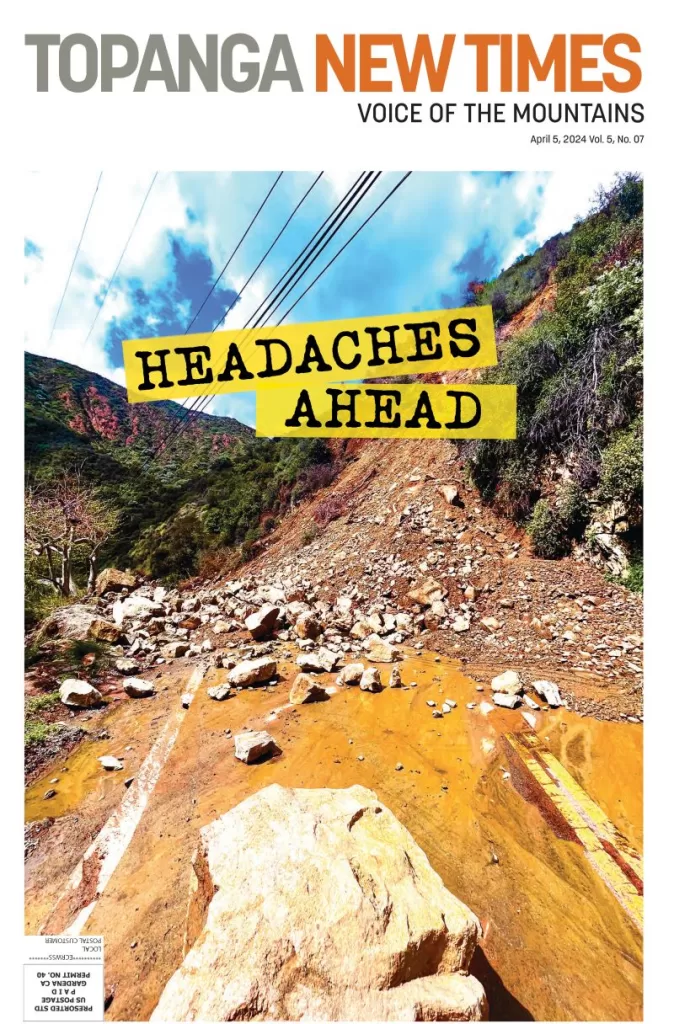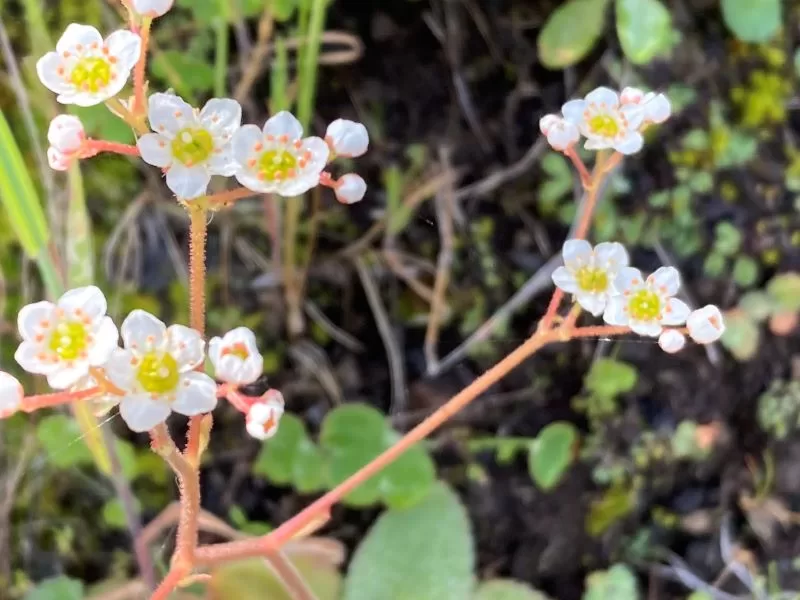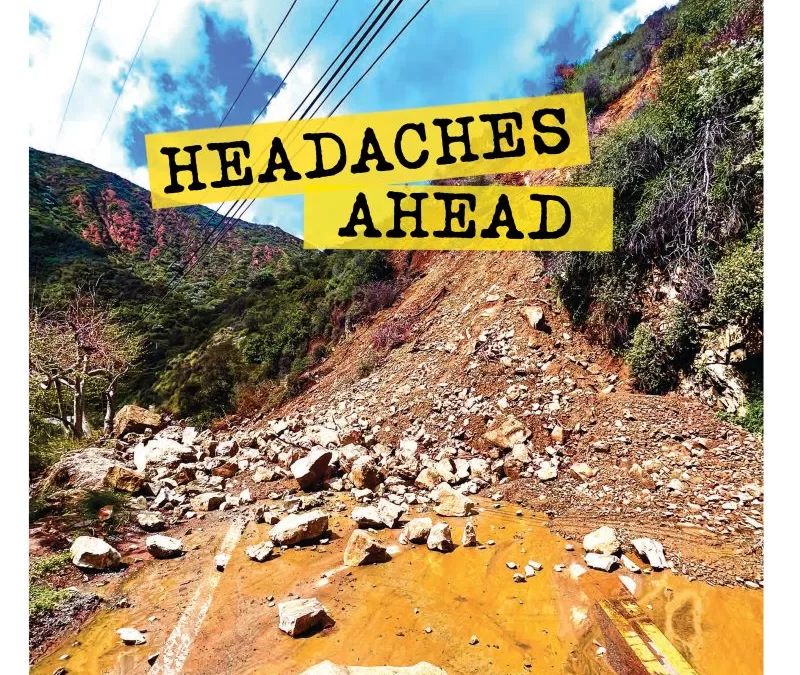
Topanga is famous for rock ’n’ roll and rolling rocks. Two months after a wall of mud and rock buried the Boulevard, Caltrans still can’t begin clearing the debris until the mountainside dries out enough to be safe for work crews to approach. This is now the biggest, most active, and most dangerous rockslide in Topanga’s history, but it isn’t the first and it won’t be the last. We have the story in our centerpiece, but it’s a story that is a long way from happy endings. The TCB closure headache will be with us for an “indefinite” period. Days? Weeks? Months? Right now, we just don’t know. Photo and cover concept and design by Urs Baur
Topanga Canyon Blvd. remains closed. We have the most current information on the slide in our Newsbeat section, but the short version is simply that the entire mountainside is moving and it is unsafe for Caltrans to work on the slide. The abundant rain over Easter weekend didn’t help. Parts of Topanga received as much as 3.43 inches. The closure is a reminder that the Santa Monica Mountains are a dynamic environment—a young range that is geologically active and sometimes surprisingly fragile.
Anyone who lives in these mountains or within their shadow for any length of time will eventually be faced with natural disaster: drought and wildfire, flooding and rockslides—it is a cycle that repeats, and one that is predicted to intensify as climate change increasingly impacts our lives. We live in a state of change. That is part of the beauty of this place, but it is also part of the price for living here.
Topanga’s businesses are open, despite the road closure. They need our support to get through this challenging time. Commutes have become complicated and even more time consuming than usual as drivers struggle to navigate around the closure. A temporary traffic signal on PCH at Tuna is expected to be installed as early as Monday, according to Caltrans officials. The goal is to prevent wrong-way drivers on the one-way road and improve safety for anyone trying to turn left onto PCH. The traffic light at Old Canyon and Mulholland Highway wasn’t universally popular when it was installed, but it has turned out to be a safety asset during the closure of TCB, enabling residents to turn left at the potentially dangerous intersection, even when traffic is heavy. Patience is needed and will continue to be needed until the situation is resolved. We’re all in this together.
We recently encountered our first rattlesnake of the season on the trail. It was a reminder that as the days lengthen, humans aren’t the only ones who will be taking advantage of spring weather. The Southern Pacific Rattlesnake—Crotalus oreganus ssp. helleri—is our only potentially dangerous venomous snake. Our native species is usually a mild-mannered reptile that prefers to avoid humans whenever possible, but bites happen, and are a serious medical emergency when they do. Call 911 and get to a hospital as quickly as possible. Pets also need immediate emergency medical aid.
It’s important to watch where one is going and never step or reach into brush without checking first to make sure that a snake isn’t snoozing there. Keeping dogs on leash when hiking and signing up for rattlesnake aversion training can help keep pets safe.
Rattlesnakes also turn up in cozy spots around the house, like under lawn furniture, flower pots, or pool covers. That can make coexistence challenging. Here at TNT we maintain a list of snake wranglers who can help safely and humanely relocate rattlesnakes: topanganewtimes.com/snake-wranglers.

The ability to see the stars on a clear night is something residents and visitors to the Santa Monica Mountains cherish, and this area still has some of the darkest skies in Los Angeles County, but that’s not saying much. The Santa Monica Mountains National Recreation Area had the third highest light pollution of all 59 National Parks in the US. An NPS study finds that since 1992, light pollution in this park has remained fairly stable, and has even slightly decreased, thanks to activists pushing for measures like downward-facing light fixtures.
Activists in Southern Oregon have worked to turn down the lighting in a 2.5 million-acre area, which was just named the largest Dark Sky Sanctuary in the world. The Oregon Outback International Dark Sky Sanctuary received its official designation from DarkSky International last month. The project is a joint effort between the Oregon Dark Sky Network, an ad-hoc group of state, local and federal officials, private individuals, business owners and tourism agencies. It’s an inspiration for all of us.
Dark skies aren’t needed to observe the biggest astronomical event of the season. Step outside at 11:11 a.m.on April 8, for a chance to see the approximately half of the sun occluded by the moon. The Santa Monica Mountains will only witness a partial eclipse on April 8, instead of the total solar eclipse that will be experienced by those fortunate people living in a narrow swath of North America from Mazatlan in Mexico to Houlton, Maine, but it’s still worth a look.
One of the easiest and safest ways to watch the eclipse is by using a kitchen colander to cast the shadow of dozens of tiny suns on the ground. A small hole in a piece of opaque paper or cardboard works well, too, but remember, never look directly at the sun. Not every solar system has the perfect arrangement of planet, moon and sun needed to create a solar eclipse. Earth is an amazing place.
Stay safe, be well. Happy April!






What is Topanga Canyon Elem doing about the school situation with road closures, etc.?
I taught there for 22 yrs. and retired in 2007.( and continued being a substitute for several years.) I still think of working there fondly, and as the best part of my life. Please send my regards to all my former students, and fellow teachers. This is Donna Workman.